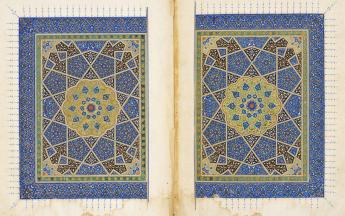First Major U.S. Exhibition of Qurâans - Freer Sackler Washington

The first major exhibition of Qur’ans (Korans) in the U.S., “The Art of the Qur’an: Treasures from the Museum of Turkish and Islamic Arts” at the Smithsonian’s Arthur M. Sackler Gallery in Washington, D.C., was opened in September 2016 and is on view through Monday, Feb. 20, 2017.
The exhibition has received outstanding reviews in the press!
“It’s a glorious show, utterly, and like nothing I’ve ever seen…” –Holland Cotter, NYT
“…some of the most beautiful and significant calligraphy and book illustration ever produced.” –Apollo
“The dazzling array of calligraphic variety across these manuscripts is astounding.” –The Economist
“…some of the finest existing examples from diverse historical eras and cultures,…” –The Guardian
“A magic visual experience” –Times of Israel
“…the loan of these items from Turkey is in the finest tradition of illuminated Qur'ans.” –Smithsonian Magazine
Number three exhibition to see in 2016 –Best Art of the Year, Holland Cotter, NYT
The landmark exhibition, organized by the Sackler and the Smithsonian’s Freer Gallery of Art in collaboration with the Museum of Turkish and Islamic Arts in Istanbul, features more than 60 Qur’ans, among the most important ever produced from the Arab world, Turkey, Iran and Afghanistan, including works from the permanent collection of the Freer and Sackler galleries plus a number of long-term loans. Celebrated for their superb calligraphy and lavish illumination, the manuscripts span almost 1,000 years of history—from eighth-century Damascus, Syria, to 17th-century Istanbul.
This landmark exhibition tells the individual stories of some of these extraordinary manuscripts, their makers and their owners. Visitors will learn how the Qur’an was transformed from an orally transmitted message into a fixed text, transcribed and illuminated by some of the most skilled artists of the Islamic world and treasured and disseminated by sultans and viziers over centuries.
Koç Holding is the exhibition’s principal sponsor, with additional support provided by Turkish Airlines, Roshan Cultural Heritage Institute, and Aydin Doğan Foundation. The exhibition was organized in cooperation with the Ministry of Culture and Tourism, Republic of Turkey.
The Freer and Sackler galleries have one of the most celebrated collections of arts from the Islamic world in the U.S. They have presented other major exhibitions featuring important religious objects and publications, including “The Tibetan Shrine from the Alice S. Kandell Collection” in 2010 and “In the Beginning: Bibles Before the Year 1000” in 2006.
The Smithsonian’s Freer Gallery of Art and the adjacent Arthur M. Sackler Gallery, located on the National Mall in Washington, D.C., together comprise the nation’s museum of Asian art. It contains one of the most important collections of Asian art in the world, featuring more than 40,000 objects ranging in time from the Neolithic to the present day, with especially fine groupings of Islamic art, Chinese jades, bronzes and paintings and the art of the ancient Near East. The galleries also contain important masterworks from Japan, ancient Egypt, South and Southeast Asia and Korea, as well as the Freer’s noted collection of works by American artist James McNeill Whistler. The Freer, which will be closed during the exhibition, is scheduled to reopen Oct. 7, 2017, with modernized technology and infrastructure, refreshed gallery spaces and an enhanced Eugene and Agnes E. Meyer Auditorium.
The Smithsonian Institution has two museums of Asian art: the Freer Gallery of Art, which opened to the public in 1923, and the Arthur M. Sackler Gallery, which welcomed its first visitors in 1987. Both are physically connected by an underground passageway and ideologically linked through the study, exhibition, and sheer love of Asian art. In addition, the Freer Gallery contains an important collection of nineteenth century American art punctuated by James McNeill Whistler's Peacock Room, perhaps one of the earliest (and certainly one of the most controversial) art installations on record.
View website for more information.
Source of information and images: Office of Marketing and Communications
Freer Gallery of Art and Arthur M. Sackler Gallery


